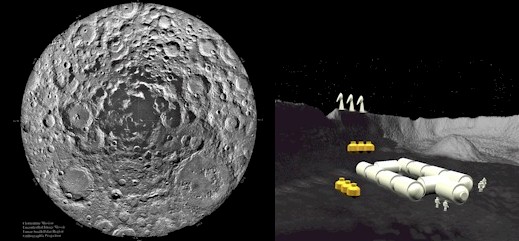 |
||
|
|
Lunar Station Using the most up-to-date Lunar data, Trans Lunar Research has selected the rugged Lunar South Pole as the primary Lunar Station site. This area, located in and around the Shackleton Crater, has been called the most valuable piece of real estate on the surface of the Moon. It is valuable for the following reasons: » There is a 99% chance of finding water ice at this location. » Adjacent to the Crater there is what has been called the "peak of eternal light". This is a point where the sun is continuously visible year round. From the vantage point of this crater rim peak, the sun is seen to perpetually revolve near the horizon, similar to the "midnight sun" effect on Earth. By placing a solar power system on this spot, year round electrical power can be generated to support a lunar colony. Trans Lunar Research has several Lunar orbital and soft-landing recon missions planned to pinpoint the exact location of the South Polar colony site. Base sites located behind the walls of Polar craters also offer several advantages over equatorial site locations: » They provide a constant temperature environment leading to a more simplified environmental control system. For example, a habitat cooling system will not be required. » The constant extreme cold at these Polar crater sites will eliminate the heat dissipation problems associated with equatorial sites where the temperature varies between 235º F and -250º F. » They provide protection from solar flares. » They provide sheltered storage areas for essential cryogenic liquids such as liquid oxygen, cryogenic fuels, and liquid nitrogen. Equatorial Lunar Station locations are not being considered at this time since solar power would only be available there two weeks per Lunar month. During the two week nights at these locations, a heavy battery system or nuclear power system would be required to produce power. In addition, water would have to be transported to these locations from the Poles. Perhaps later, when an infrastructure is developed, these equatorial sites will be utilized. Lunar
Station Construction »
Lunar
Habitat Canister »
Agricultural Canister »
Life
support module »
Communication
unit »
Power supply module » Oxygen and Nitrogen storage units » Food Supply modules »
Oxygen
manufacturing units (processing indigenous lunar material) As soon as the first to Lunar explorers land at the station, an excavation machine and an Agricultural Canister will be sent. Excavation machinery will be in the form of a lightweight bulldozer or other form of earth moving equipment. The
primary task of the initial occupants of the Lunar Base will to
set up the oxygen generator, agricultural unit, and water processing
equipment in order to increase the stay time. The first series of Station
occupants will remain 30 days on the Moon. When the self-sustaining
systems are up and running, the stay times will increase to one year or
longer. One manned and one unmanned mission are planned per month. It is expected that after two years, the population of the Lunar Station will reach 40. A series of Habitat Canisters (HC's) will be connected together to form an eleven canister Main Station Unit. Stakes and cable winches will be used to pull the HC's together into a ring structure. Once assembled, each eleven-canister Main Station Unit will be buried in Lunar regolith (soil) to protect the occupants from cosmic radiation. Each Main Station Unit will have one Agricultural Canister to provide food, carbon dioxide cleansing, and waste water processing for its 40 person population. The data and experience gathered by the initial 40 person Lunar Station population will be used to improve the design of the next Main Station unit. The construction of the manned Lunar Station will require up to $800 million. Your financial support is urgently needed. |
xxxxxxxxxxxxx |
|
Copyright © 2009 Trans Lunar Research All Rights Reserved |
||
|
|
||
|
|
||



